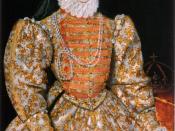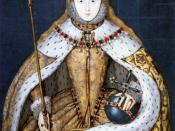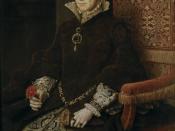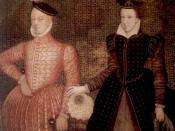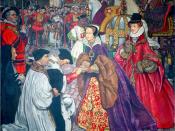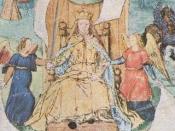�PAGE � Randell �PAGE �1�
Kly Randell
English 2322
Samuelson
3 July 2007
A Historical View of Mary the Queen of Scot's Relationship with England
When people think of the most influential monarchs in the history of the world they think of King James, the fictitious Arthur, and Queen Elizabeth. However, they always fail to remember Mary Queen of the Scots in that most famous group. Cousin to Queen Elizabeth I, Mary was probably more famous in her time than the great Queen of England. She was once thought and believed to be the rightful ruler of England instead. That plain and simple idea sparked years of rivalry between the two Queens. During the years of Mary's life, her relationship with Elizabeth I was full of jealousy and distrust, although Mary's influence lived long after her death.
Mary was born on December 8, 1542. She became the Scottish Queen on December 14, 1952.
Not only did she have ties to the Scottish throne, but as "Henry VII of England's great-granddaughter, Mary was next in line to the English throne" (Marshall). Long before Mary's birth had the Scottish fought with the English. Scottish nobility had decided that it was time to make peace with their neighbor and made a wedding match of Mary and Henry VIII's son Edward. Unfortunately, things did not get better between England and Scotland because the Catholics of Scotland opposed the plan and instead had Mary wed to the French King Henri II's son, the Dauphin Francis. Because of this broken pact, Henry of England ordered a "savage series of raids into Scotland known as 'The Rough Wooing'" (Marshall).
While the broken pact with England started off the downhill relationship with England for Mary, the passing of Queen Mary I of England did not make matters any easier. Her father-in-law encouraged her to "assume the royal arms in England" (Strickland). In fact, most of Catholic Europe saw Mary as the next ruler of England, and this would "cause serious repercussions throughout Mary's life" (Strickland). While this was not the first battle between Scotland and England, it was the first true test between Mary and her cousin Elizabeth I. Elizabeth never got over the fact completely that Mary was thought to have been the next heir in England, although she finally agreed that it was not Mary's intention to rule over England.
In 1559, the king of France died and Mary and the Dauphin were crowned King and Queen of France. At this moment in time, Mary is the Queen of two independent countries. This brings Elizabeth to fear Mary's power and her astounding leadership abilities. This also rekindles Elizabeth's fears of Mary taking over the throne of England. Not only does the fear of Mary's growing power come about, but so does jealousy of her cousin.
The year 1560 was a very tough year for Mary. Her mother died back in Scotland and not six months later her "young husband died . . . after a reign of seventeen months" (The World). This left Mary as the sole ruler of two sovereign nations. She was "unwilling to stay in France and live under the domination of her mother-in-law" so she left and headed for the newly Protestant Scotland. While the fear grows even more within Elizabeth, Mary is not at all concerned about England. In fact she did not even wait for a safe-conduct pass from England before embarking across the English seas back home to her native Scotland. Because of that, Elizabeth's ships follow and patrol her route.
Mary's return to Scotland was received with "great joy and celebration" (Morris). Mary immediately tried to help and end the suffering. She knew that she was succeeding a "most troubled heritage" (Marshall). However, she wanted to make a difference and start a new reign for her Scotland. She tried to keep peaceful relations with all of her neighboring, powerful countries: France, Spain, and even for a short lived time England. What was so astonishing about this fact is that she accomplished this without signing any treaties at all. While it would of given Scotland protection from invasion, it might of also brought Scotland into a war it did not need. While she never met Elizabeth face to face, "her patience was tried by the English ambassador's persistent and obvious spying" (Marshall).
After a failed attempt to negotiate a Catholic marriage to the son of Phillip II of Spain, she married her first cousin Henry Stewart, Lord Darnley in July of 1565. Her marriage was "unacceptable to the Protestants" and therefore caused a rebellion. In 1566 they welcomed their son the future James VI of Scotland as the future heir to the throne. Elizabeth I watched these events not only with interest, but jealousy and amusement as well. She knew that her choice to remain unmarried and childless most undoubtedly meant that not only would James VI be the future ruler of Scotland, but also of her England.
Trouble for Mary started when her husband Darnley was murdered by his own nobles. In fear for her own life and the life of her newborn son she agreed to marry one of the nobles implicated in the crime, James Hepburn, Earl of Bothwell. He had shown Mary an agreement the nobles had signed that said they would accept him as their King. However, they still did not rest and eventually told Mary to abandon Bothwell. She refused and to avoid bloodshed she turned herself over to the rebels. The rebel nobles had finally forced her to abdicate her throne to her one year old son after she became extremely ill. One of her keeper's brother helped her escape from prison and after a battle that her and her supporters lost, decided to go south and seek the help from her cousin, Elizabeth I. This was just the start of another time of suffering for Mary.
When Mary finally landed in England, Elizabeth immediately had her locked up in the north of England. It was unaware to Mary, but Elizabeth had actually helped Mary's enemies. For a long time, Elizabeth had provided money and sanctuary to them in return for causing problems for Mary. Elizabeth was scared and jealous for two reasons. Mary had almost as much right to the English throne as Elizabeth and Elizabeth was afraid that some of the Catholic people in her kingdom would love to make Mary Queen of Scotland and England. Therefore, by helping Mary's enemies, this would cause "continual strife" in Mary's kingdom (Bruce). Mary was kept in prison for 19 years. This was mostly because of the "Casket Letters". The "Casket Letters" were "supposedly letters and other papers belonging to Bothwell and found in his casket" that possibly implicated Mary in the murder of her husband Darnley (Marshall). They were finally determined to be forgeries. Elizabeth said of the "Casket Letters", "Nothing had been sufficiently proved, whereby the Queen of England should conceive an evil opinion of her good sister" (Goodare).
From the moment Mary was imprisoned and held against her will she had planned and plotted to escape. She was moved from prison to prison and finally ended at Fotheringhay Castle. Elizabeth was always in fear that while Mary was in England, even imprisoned, she was plotting to kill her and take the throne for herself and rule England and Scotland. As the years progressed the plots grew more "outlandish and murderous" (Marshall). Finally, in October of 1586, Mary was officially charged with plotting to kill the Queen of England and claim the English throne for herself. Marshall reproduced this letter written by Elizabeth to Mary explaining her side of the story:
You have in various ways and manners attempted to take my life and to bring my kingdom to destruction by bloodshed. I have never proceeded so harshly against you, but have, on the contrary, protected and maintained you like myself. These treasons will be proved to you and all made manifest. Yet it is my will, that you answer the nobles and peers of the kingdom as if I were myself present. I therefore require, charge, and command that you make answer for I have been well informed of your arrogance. Act plainly without reserve, and you will sooner be able to obtain favour of me.
The trail lasted for just two days and was over on October 16, 1586. Although Mary defended herself very admirably, it was known that the decision was made long before the trial even began. Although the trial was over in a hurry, it was not until February 7, 1587 that Mary was told that she was to be executed the next day. In her final hours she made and will and wrote letters to her son and close friends back in Scotland. The morning of her execution she was dressed in all black and looked very composed and calm, in contrast to her maids and servants who were very hysterical. As she laid her head down for the executer, he was very unsteady and the first blow with the axe sliced the back of her head, and the second was fatal. Surprisingly, as he went to hold up her head, they found that she was actually wearing a wig. Her head fell down and rolled to the ground.
Mary's life was indeed full of tragedy, but it was also full of inspiration. The end of her life marked the beginning of her legend. Catholic nations celebrated her as a "martyr" (Morris). Henri III of France held a funeral mass in her honor and thousands came to worship her life. Then a year later, urged on my Mary's execution Spain invaded England. Her son James moved her body to Westminster Abbey sixteen years later and constructed a marvelous tomb that rivaled Elizabeth's.
It is common to think that if Mary had not been executed by her jealous cousin that she would have surpassed Elizabeth as a more famous and inspiring monarch. Her good deeds she did in Scotland have not received as much recognition as they deserved. But the legend of Mary Queen of the Scots will live forever.
Works Cited
Bruce, John, and Allan J. Crosby. "Accounts and Papers Relating to Mary Queen of Scots." A Rememberance of the Order and Manner and of the Burial of Mary Queen of Scots os (1867): 1-134.
Goodare, Julian. "Mary Queen of Scots." My Heart is My Own: the Life of Mary Queen of Scots os (2006): 1-15.
Marshall, Rosalind. "History of the Monarchy." Kings and Queens of Scotland. 2006. Royal Household. 23 June 2007 <http://www.royal.gov.ik>.
Morris, Jean. The Monarchs of England. New York: Charterhouse, 1975.
Strickland, Agnes, ed. "Mary, Queen of Scots." English History. Apr. 2004. 23 June 2007 <http://englishhistory.net>.
"The World of Mary Queen of Scots." Marie Stuart. 23 June 2007 <http://www.marie-stuart.co.uk>.
�
A Historical View of Mary Queen of the Scots Relationship with England
THESIS: During the years of Mary's life, her relationship with Elizabeth I of England was full of jealousy and distrust, although Mary's influence lived long after her death.
I. Start of a bad relationship with her sister England.
A. Crowning of the Queen of Scotland at six days old.
B. Broken pact with England over Mary's marriage.
1. Planned to make peace with England, but Catholics opposed.
2. Took Mary to France instead to wed the Dauphin Francis.
3. Henry of England ordered raids in Scotland.
II. Passing of Queen Mary I of England.
Most in Catholic Europe saw Mary as next heir.
Cause serious repercussions throughout her life.
Elizabeth I never forgot this offense and was uneasy while Mary was alive.
Jealousy grows as does distrust.
A. Henry II of France passes.
1. Mary and her husband crowned Queen and King of France.
2. Mary is Queen of France and Scotland.
a. Elizabeth fears Mary's power and her leadership.
b. Elizabeth also begins to grow jealous.
B. Mary's husband dies of ear infection.
1. Mary is the sole ruler of two countries.
a. Leaves a lot of power in the hands of one person.
b. Fear within Elizabeth grows.
2. Mary is unconcerned about England
3. Leaves for Scotland.
a. Goes without a safe-conduct pass from Elizabeth.
b. Elizabeth's ships follow and patrol her route.
C. Return to Scotland
1. Mary returns to Scotland and tries to help and please.
a. Keeps peaceful relations.
i. France
ii. Spain
iii. Even England for a short while.
Kept peace with France and Spain with no treaties.
i. Treaty would of given Scotland protection
ii. Did not want to compromise her subjects.
c. Patience tried by English ambassador's obvious spying.
D. An heir arrives
1. Mary marries Cousin Henry Stewart Lord Darnley.
2. Gives birth to son, James IV.
3. Elizabeth watches on with jealousy and amusement.
a. James IV most likely heir to both Scotland and England.
b. Elizabeth's choice to remain unmarried and childless.
E. Trouble for Mary
1. Darnley murdered by his own nobles.
a. In fear, consented to wed Bothwell.
b. Nobles did not like so the forced her to abdicate.
c. Eventually escaped prison to flee to England.
F. Mary sets sail for England
1. Elizabeth kept Mary guarded, unsure of what to do.
2. Elizabeth had helped Mary's enemies
a. Mary was unaware of this.
b. Elizabeth promised money and sanctuary.
3. Elizabeth scared and jealous for two reasons.
a. Mary was closest Catholic claim to throne.
b. Elizabeth knew some of her subjects hoped Mary would reign.
c. Therefore was determined to keep Scotland in strife.
4. Mary kept in prison for 19 years.
a. Mostly because of Casket Letters
5. Casket Letters
a. Supposedly letters and other papers belonging to Bothwell and found in his casket.
b. Forgeries.
c. Determined nothing had been proved to implicate Mary in murder of Darnley.
III. Mary's Death
Charges
1. Mary plotted from the beginning to escape
2. Elizabeth feared she was plotting to kill her instead.
3. As the years passed the plots grew more outlandish and murderous
4. October 1586, Mary officially charged with plotting to kill Elizabeth and claim the English Throne.
Trial
1. Last two days and was over on October 16, 1586.
2. Defended herself admirably.
3. Verdict had been decided before proceedings had begun.
C. Execution
1. Told Mary February 7, 1587 that she was to be executed the next day.
2. She spent her final hours making a will and writing letters.
3. Dressed in black and was very calm and composed.
4. First strike of the axe cut her head, and the second was the fatal blow.
5. When the executioner held up her head, he found she was wearing a wig and her head fell to the ground and rolled.
IV. After the Death of the great Queen of Scots.
End of her life marked the beginning of her legend.
Catholic nations celebrated her as a martyr.
Henri III of France held funeral mass.
A year later Spain invaded England, urged on by Mary's Execution.
16 years later her son James moved her body to Westminster Abbey and constructed a magnificent tomb that was better than Elizabeth's.
